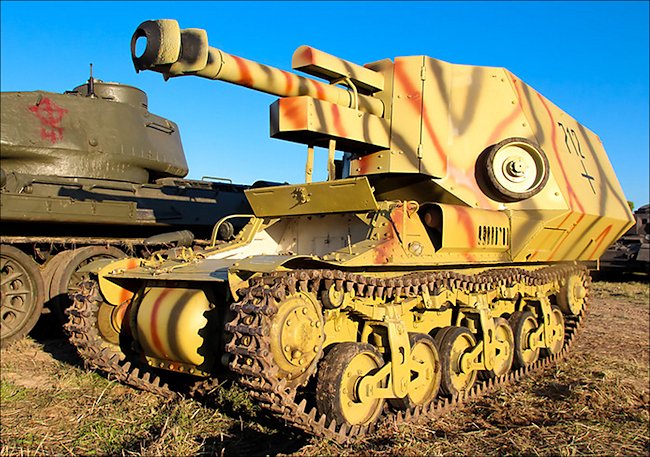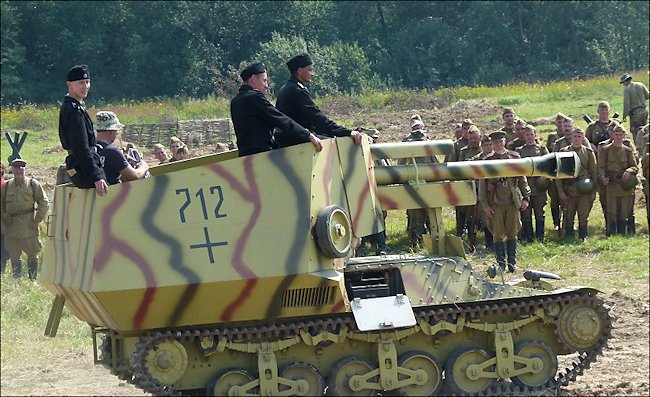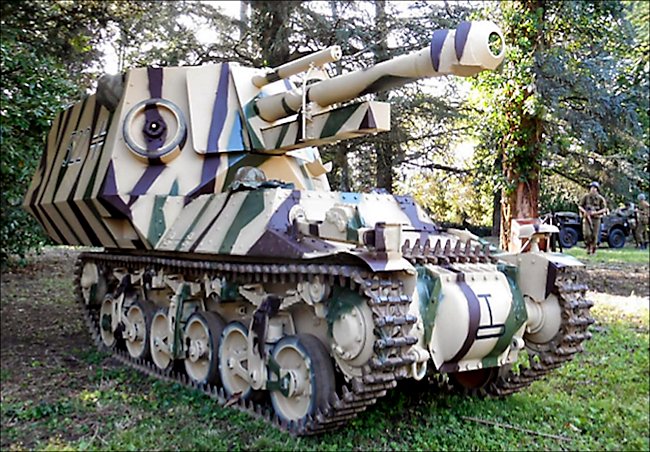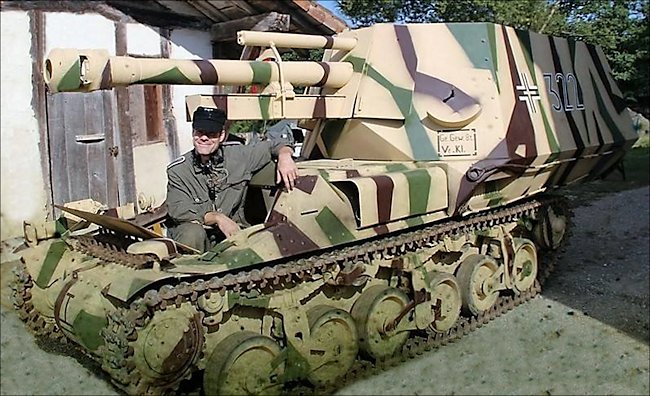10.5cm leFH-18/40 auf Geschuetzwagen Lorraine Schlepper(f)
There are two surviving WW2 rebuilt German 10.5cm leFH-18/40 auf Geschuetzwagen Lorraine Schlepper(f) self propelled artillery guns left in the world.

German 105mm leFH-18/40 auf Geschuetzwagen Lorraine Schlepper(f) Self propelled artillery gun (Arkett 1942 version) in Russia
Location
You can normally only see these two restored 10.5cm leFH-18/40 auf Geschuetzwagen Lorraine Schlepper(f) self propelled artillery guns at historical military vehicle reenactment events in France and Russia. The Russian owned vehicle has appeared in the annual international gathering of military vehicles called 'Engines of War' (warmotors.ru). It is kept at the Central Museum of the Great Patriotic War 1941 - 1945, Park Pobedy, Moscow, Russia. The French SPG is in a private collection and is owned by François Couderc
Specifications
It was powered by a Type 135 Delahaye 6 cylinder inline petrol engine that produced 70hp. It had a top road speed of 35km/h (22 mph)and an operational range of around 137 km (85 miles). It had a 4 man crew; Commander, driver, gunner, loader. The Lorraine 37L tractor chassis had frontal armour thickness of 9mm but the bulbious nose was 12mm thick. The side and rear armour was 9mm thick which would only just about stop a bullet.
It was armed with a 105m leFH 180 howitzer. The letters 'LeFH' are not French. They stand for 'leichte Feldhaubitze' which translates to 'Light Field Howitzer'. It fired 14.81 kg (32.7 lb) high explosive HE shells and in an emergency 14.25 kg (31.4 lb) armour piercing AP rounds. Its maximum firing range was 10,675m - 10.67 km (11,675 yards - 6.63 miles). It could carry 20 rounds.

German 105mm leFH-18/40 auf Geschuetzwagen Lorraine Schlepper(f) Self propelled artillery gun (Arkett 1942 version) at the 'Engines of War event in Russia
The Russian SPG
The restored Russian owned SPG was found in a scrapyard in Turn, France which is near to the last battle in the Falaise Pocket. A Russian military vehicle restorer and collector rescued the vehicle and transported it to Moscow. It was initially thought that the vehicle was an anti-tank Marder I but when the wreck was properly examined in Moscow it was found to be the only surviving original 10.5cm leFH 18/40 auf GW Lorraine Schlepper(f) SPG left in the world.
During restoration identity marks were found to show that it was part of the 7th battery of the 155th Panzerartillerie-Regiment, 21st Panzerdivision in the Summer of 1944. The howitzer was missing but after a number of years searching a replacement original 10.5 cm leFH-18/40 gun was found and fitted. The French vehicle was a new build from an original Lorraine 37L tractor and a 10.5 cm leFH-18/40 gun
They fought in Normandy
On D-Day 6th June 1944 the German 155th Armoured Artillery Regiment, 21st Panzer Division was equipped with 10.5cm leFH-18/40 auf Geschuetzwagen Lorraine Schlepper(f) self-propelled artillery guns and a collection of other Lorraine 37L and Hotchkiss self-propelled gun conversions. The assault gun battalion Sturmgeschutz Abteilung 200, 21st Panzer Division was also equipped with French Army vehicle SPG conversions. The 200th had 4 companies, each with four anti-tank 75mm PaK 40 Marder I SPGs and six 105mm self propelled artillery guns. The 155th Armoured Artillery Regiment was made up of 105mm and 150mm self propelled artillery guns.
Although suffering losses of tanks and assault guns the official regimental records record that four weeks after D-day none of the Lorraine conversions had been lost. That was not to last. Following the heavy fighting around Caen the last ones were knocked out when they were caught in the Falaise Pocket and subjected to intense bombing, shelling and gun fire in August 1944.

German 105mm leFH-18/40 auf Geschuetzwagen Lorraine Schlepper(f) Self propelled artillery gun (Arkett 1942 version) in France
The Lorraine 37L
During WW1 the French and British Army needed a way to transport ammunition and supplies to the front line. Men and horses were getting killed and injured from small arms fire and exploding shell fragments. Tracked armored supply vehicles were developed. This vehicle was developed by the Lorraine company in 1937 as a replacement for the smaller Renault UE. It could transport a heavier load and was faster than the Renault UE. Production began in January 1939. By the time France surrendered in 1940 a total of 432 Lorraine 37L armoured supply tractors had been produced.Baukcommando Becker
Alfred Becker was Commanding Officer of the German assault gun battalion Sturmgeschuetz-Abteilung 200, which was part of 21.Panzer Division, when the Allies landed in Normandy 6th June 1944. Prior to that date, Becker had under his command soldiers, engineers and mechanics that came to be known as the Baukcommando Becker (Becker’s Construction Command). The British and French Army tanks and vehicles still left in occupied France were mainly scrap, destroyed, blown apart and gutted. He had worked with the German company Alkett, just outside Berlin, to produce converted improvised armoured fighting vehicles.
Becker was sent to France after he gave a presentation to Hitler in September 1942 on how artillery and anti-tank guns could be fitted onto captured French military Lorraine tractor units and obsolete tank chassis. His headquarters was in the Maisons-Laffitte, in a former French military camp. It was chosen because of its close proximity to the former Hotchkiss tank factory. Becker’s men collected a variety of vehicles from all over France: from ditches by the side of the road, rivers, hidden warehouses, the beaches near Dunkirk, French army camps and battlefields.

German Hotchkiss 105mm le.FH 18 (Sf.) auf GW-39H(f) Self propelled Gun
Most of the time, there was nothing left but a bare skeleton chassis. They transported them to different factories and mechanical workshops. There, these vehicles were assessed, sorted and disassembled. One group of Becker’s men cleaned the parts, while others put the vehicles on an assembly line, where they were put back together, modifying them in the process. The completed vehicles looked like they were factory fresh.
German Armored Fighting Vehicles that were captured enemy tanks were known as ‘Beutepanzer’, which, when translated, means ‘trophy tanks’. Captured tank chassis were converted into self-propelled artillery and anti-tank guns. The Baukommando also produced self-propelled Nebelwerfer rocket firing artillery and troop transports from captured enemy vehicles. Initially, the completed vehicles were sent to the Eastern Front or to North Africa. Later, with the threat of an Allied invasion, they were deployed in France.
WW2 tank books

